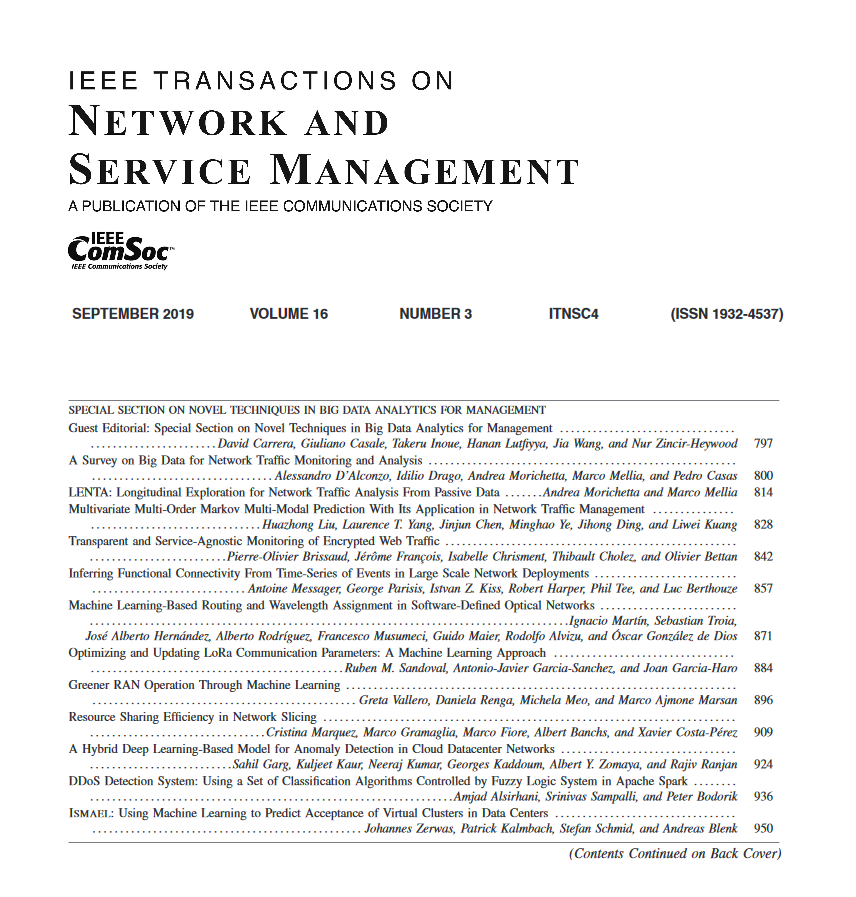开放无线接入网络中 eMBB-URLLC 复用的分布式学习框架
IF 4.7
2区 计算机科学
Q1 COMPUTER SCIENCE, INFORMATION SYSTEMS
IEEE Transactions on Network and Service Management
Pub Date : 2024-08-28
DOI:10.1109/TNSM.2024.3451295
引用次数: 0
摘要
下一代(NextG)蜂窝网络预计将向虚拟化和开放性方向发展,并采用可重新编程的组件,以促进智能化和实时分析。本文以这些创新为基础,解决多蜂窝开放式无线接入无线网络中的网络切片问题,重点关注两种关键服务:增强型移动宽带(eMBB)和超可靠低延迟通信(URLLC)。随机资源分配问题的目标是平衡平均 eMBB 数据速率及其方差,同时确保 URLLC 约束条件。根据开放无线接入网络(O-RAN)架构,开发了基于深度强化学习(DRL)技术的分布式学习框架,以解决所提出的优化问题。所提出的学习方法能够在中央云服务器上训练全局机器学习模型,并将其共享给边缘服务器执行。具体来说,深度学习代理分布在网络边缘服务器上,并嵌入近实时无线接入网智能控制器(Near-RT RIC)中,以收集网络信息并执行在线执行。全局深度学习模型由嵌入在中央服务器非实时 RIC(Non-RT RIC)内的中央训练引擎利用从边缘服务器接收到的数据进行训练。仿真结果验证了所提算法在实现 URLLC 约束的同时保持 eMBB 服务质量(QoS)的有效性。本文章由计算机程序翻译,如有差异,请以英文原文为准。
Distributed Learning Framework for eMBB-URLLC Multiplexing in Open Radio Access Networks
Next-generation (NextG) cellular networks are expected to evolve towards virtualization and openness, incorporating reprogrammable components that facilitate intelligence and real-time analytics. This paper builds on these innovations to address the network slicing problem in multi-cell open radio access wireless networks, focusing on two key services: enhanced Mobile BroadBand (eMBB) and Ultra-Reliable Low Latency Communications (URLLC). A stochastic resource allocation problem is formulated with the goal of balancing the average eMBB data rate and its variance, while ensuring URLLC constraints. A distributed learning framework based on the Deep Reinforcement Learning (DRL) technique is developed following the Open Radio Access Networks (O-RAN) architectures to solve the formulated optimization problem. The proposed learning approach enables training a global machine learning model at a central cloud server and sharing it with edge servers for executions. Specifically, deep learning agents are distributed at network edge servers and embedded within the Near-Real-Time Radio access network Intelligent Controller (Near-RT RIC) to collect network information and perform online executions. A global deep learning model is trained by a central training engine embedded within the Non-Real-Time RIC (Non-RT RIC) at the central server using received data from edge servers. The performed simulation results validate the efficacy of the proposed algorithm in achieving URLLC constraints while maintaining the eMBB Quality of Service (QoS).
求助全文
通过发布文献求助,成功后即可免费获取论文全文。
去求助
来源期刊

IEEE Transactions on Network and Service Management
Computer Science-Computer Networks and Communications
CiteScore
9.30
自引率
15.10%
发文量
325
期刊介绍:
IEEE Transactions on Network and Service Management will publish (online only) peerreviewed archival quality papers that advance the state-of-the-art and practical applications of network and service management. Theoretical research contributions (presenting new concepts and techniques) and applied contributions (reporting on experiences and experiments with actual systems) will be encouraged. These transactions will focus on the key technical issues related to: Management Models, Architectures and Frameworks; Service Provisioning, Reliability and Quality Assurance; Management Functions; Enabling Technologies; Information and Communication Models; Policies; Applications and Case Studies; Emerging Technologies and Standards.
 求助内容:
求助内容: 应助结果提醒方式:
应助结果提醒方式:


